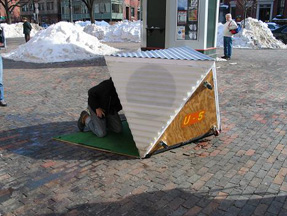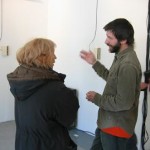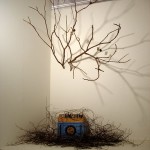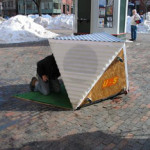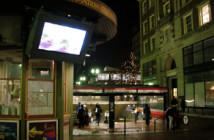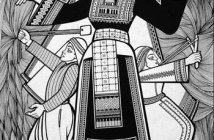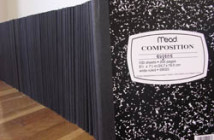BRI:AIR, a Retrospective
Projects from the Berwick Research Institute’s Artist in Research Program
Mills Gallery at Boston Center for the Arts
February 4 – March 27
Curator: Meg Rotzel
Exhibition Design: +/- (Ben Durrell and Matthew Christensen)
artists: Amy Sharp, installation; David Webber, sound & robots; Jessica Rylan, sound installation; John Osorio Buck, 2D; Christy Georg, kinetic sculpture; Aliza Shapiro, Architectural Design; Brendon Wood and Jonah Rapino from Devil Music, contemporary composition; Vaughn Bell, environmental installations and sculpture, biospheres; Carolyn Lambert and Fereshteh Toosi, 2D documentation of public investigations; Ken Linehan, sound sculptures; and Heather Kapplow, installation.
_
The Berwick Research Institute calls their residency program, “Artist in Research.” Each stint, a precious gift of time, money, space, and interested colleagues, is loosely bound by the “hypothesis” that each artist proposes in advance of receiving the residency. The BRI:AIR brand of art endeavor is definitively non-intuitive in its procedures and evaluation. The artists propose to direct themselves and their work whilst in residence by means other than aesthetics or capricious games of chance – when you think about it, this is an extraordinary model for coaxing art out of life. The Berwick allows for, and actually requires, artfulness in sheer information arraying, bracketing, and massaging. They are one obviously on the move, up-and-coming, collaborative artist’s organization and the AIR program is their showpiece.
The work held in the Mills Gallery was a set of almost Duchampian delays in the process and feedback of the BRI:AIR. They were charming and delightful in spots. Jessica Rylan’s untitled (Nature Diorama with Natural Synthesizer and Electronic Birds), and Ken Linehan’s Studies in Total Information Awareness were rad ideas that were fully executed and conveyed. The operating factor in both Rylan and Linehan’s pieces (best summed up as devices for wielding the built sonic landscape) came by yoking pure information – electric circuits and magnetism, as found in credit card strips—to found, modified resonators. These were certainly the two wonkiest pieces in the gallery, and perhaps that is why they come off so well here. Rylan’s diorama was also visually arresting. The soundscape of “bird calls” lent a static-y crackliness to the outlines of the installed tree branches.
However, as a standalone experience, the Mills Gallery exhibit is disappointing. I think a gallery retrospective in 2005 is poorly timed; the Berwick itself was founded just five years ago. Surely the most potent (but least easily made public) result of BRI:AIR will be resonances of time spent in a alien studio of one’s own, as it works in the artist’s consciousness many years from now. Summarizing a loosely linked set of in-progress intellectual pursuits by means of an attractive poster or two, or an interactive exhibit, does not equal “research” that is innovative, exciting, pretty, or even useful and reproducible--if we want to get academic about the point of research and its inherent public utility. However, such summaries do make for strong whiffs of middle school science fair. Within the Berwick’s retrospective, the resident artists’ hypotheses often became inert precipitates. I found that the borrowed, standardized formats of hypotheses and reports was a distraction from what I know to be the ongoing, joyful generosity of the AIR program (after all, standardized reports also distract and warp data in the fields that seem to have generated them -- science and industry.) Carolyn Lambert and Fereshteh Toosi’s *tea*party* was the saddest casualty of the low resolution afforded by photos, wall text, and video. Over fall 2004, the two artists engaged in punning political commentary. They dressed in Colonial Outfits, and fashioned an ongoing tea party for the age, protesting breaches of our personal securiTEA, fideliTEA, etc., (get it?) by our nation’s administration. This sort of social sculpture never sounds good in summary, nor in e-mail blasts such as the ones I received at the time of their residency, and did not look good on the gallery walls. I can imagine, however, that their work was slyly effective in situ.
The sweetest use of low-resolution media –again, 2-D images and wall text—was Vaughn Bell’s (made, I believe, in collaboration with Meg Rotzel). Slides of text fragments of recollections and reveries were projected above two portable landscapes, an accordion book with simple pencil drawings and text, and a reused (and foreign) cookie tin filled with a pillow-like piece of moss. I found the whirling thoughts about dislocation, place, and space, that Bell’s slides conjured to be a pleasant heuristic for handling all the artworks described by the exhibit.
Many of the AIR participants shown seemed to have worked on designing and building actual alternate platforms for interchange and success -- John Osorio Buck, Aliza Shapiro, Heather Kapplow. With the freshly planted musings suggested by Bell, I imagined that the artists’ own positions within an alternate space, the borrowed studio of the Berwick labs, might have made them feel like they were working with the shape-shifting monkey of the partitions of “difference” on their backs. I liked this. It seems right. For example, this exhibit’s design by Matthew Christensen and Ben Durrell (their collaboration goes by +/-) included a “mobile studio,” a low-rise wooden platform on casters which was to “function as an ideological and physical platform for lectures, performances and residencies.” An astute curator, Rotzel sought to build some of the real-time functions of the AIR program into the exhibit, and various AIR alums were scheduled to commandeer the platform, and gallery, over its run. However, when I went to see the show on its final Friday night, the artists-in-residence were simply lounging on this mobile studio and talking with each other in stagy fashion. My friends and I ignored them the whole time, unsure how to engage their platform sitting. The artists, in turn, never looked outside their platform. This is some interesting hit-or-miss turf that the Berwick is putting down. I think it will be most cool to look back at it in time-lapse mode.
- Ken Linehan, AIR Resident: August – December, 2004, demonstrating Studies in Total Information Awareness
- Jessica Rylan: AIR Resident: August – October 2002, installation example of Nature Diorama
- John Osorio-Buck AIR Resident: June – August, 2003, moving/living in Prototype (Utopia 5) from Waste Structure Series: Inside Space for Outside
Links:
The Mills Gallery, Boston Center for the Arts
Berwick Research Institute
"BRI: AIR" was on view until March 28th at the Mills Gallery located in the Boston Center for the Arts.
All images are courtesy of the artists, the Berwick Research Institute and the Mills Gallery

